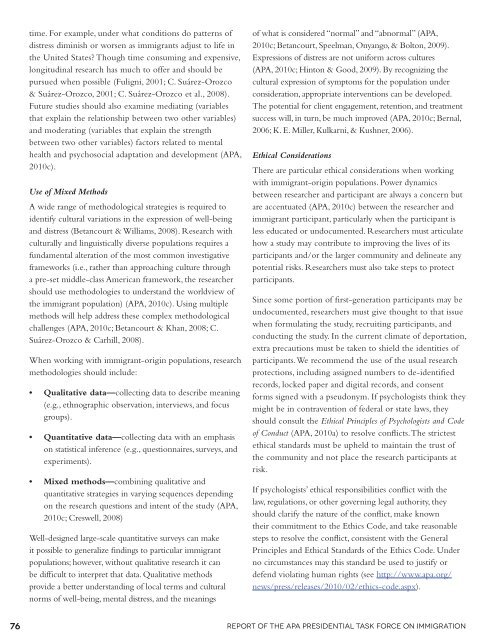Crossroads: The Psychology of Immigration in the New Century
Crossroads: The Psychology of Immigration in the New Century
Crossroads: The Psychology of Immigration in the New Century
You also want an ePaper? Increase the reach of your titles
YUMPU automatically turns print PDFs into web optimized ePapers that Google loves.
time. For example, under what conditions do patterns <strong>of</strong><br />
distress dim<strong>in</strong>ish or worsen as immigrants adjust to life <strong>in</strong><br />
<strong>the</strong> United States? Though time consum<strong>in</strong>g and expensive,<br />
longitud<strong>in</strong>al research has much to <strong>of</strong>fer and should be<br />
pursued when possible (Fuligni, 2001; C. Suárez-Orozco<br />
& Suárez-Orozco, 2001; C. Suárez-Orozco et al., 2008).<br />
Future studies should also exam<strong>in</strong>e mediat<strong>in</strong>g (variables<br />
that expla<strong>in</strong> <strong>the</strong> relationship between two o<strong>the</strong>r variables)<br />
and moderat<strong>in</strong>g (variables that expla<strong>in</strong> <strong>the</strong> strength<br />
between two o<strong>the</strong>r variables) factors related to mental<br />
health and psychosocial adaptation and development (APA,<br />
2010c).<br />
Use <strong>of</strong> Mixed Methods<br />
A wide range <strong>of</strong> methodological strategies is required to<br />
identify cultural variations <strong>in</strong> <strong>the</strong> expression <strong>of</strong> well-be<strong>in</strong>g<br />
and distress (Betancourt & Williams, 2008). Research with<br />
culturally and l<strong>in</strong>guistically diverse populations requires a<br />
fundamental alteration <strong>of</strong> <strong>the</strong> most common <strong>in</strong>vestigative<br />
frameworks (i.e., ra<strong>the</strong>r than approach<strong>in</strong>g culture through<br />
a pre-set middle-class American framework, <strong>the</strong> researcher<br />
should use methodologies to understand <strong>the</strong> worldview <strong>of</strong><br />
<strong>the</strong> immigrant population) (APA, 2010c). Us<strong>in</strong>g multiple<br />
methods will help address <strong>the</strong>se complex methodological<br />
challenges (APA, 2010c; Betancourt & Khan, 2008; C.<br />
Suárez-Orozco & Carhill, 2008).<br />
When work<strong>in</strong>g with immigrant-orig<strong>in</strong> populations, research<br />
methodologies should <strong>in</strong>clude:<br />
• Qualitative data—collect<strong>in</strong>g data to describe mean<strong>in</strong>g<br />
(e.g., ethnographic observation, <strong>in</strong>terviews, and focus<br />
groups).<br />
• Quantitative data—collect<strong>in</strong>g data with an emphasis<br />
on statistical <strong>in</strong>ference (e.g., questionnaires, surveys, and<br />
experiments).<br />
• Mixed methods—comb<strong>in</strong><strong>in</strong>g qualitative and<br />
quantitative strategies <strong>in</strong> vary<strong>in</strong>g sequences depend<strong>in</strong>g<br />
on <strong>the</strong> research questions and <strong>in</strong>tent <strong>of</strong> <strong>the</strong> study (APA,<br />
2010c; Creswell, 2008)<br />
Well-designed large-scale quantitative surveys can make<br />
it possible to generalize f<strong>in</strong>d<strong>in</strong>gs to particular immigrant<br />
populations; however, without qualitative research it can<br />
be difficult to <strong>in</strong>terpret that data. Qualitative methods<br />
provide a better understand<strong>in</strong>g <strong>of</strong> local terms and cultural<br />
norms <strong>of</strong> well-be<strong>in</strong>g, mental distress, and <strong>the</strong> mean<strong>in</strong>gs<br />
<strong>of</strong> what is considered “normal” and “abnormal” (APA,<br />
2010c; Betancourt, Speelman, Onyango, & Bolton, 2009).<br />
Expressions <strong>of</strong> distress are not uniform across cultures<br />
(APA, 2010c; H<strong>in</strong>ton & Good, 2009). By recogniz<strong>in</strong>g <strong>the</strong><br />
cultural expression <strong>of</strong> symptoms for <strong>the</strong> population under<br />
consideration, appropriate <strong>in</strong>terventions can be developed.<br />
<strong>The</strong> potential for client engagement, retention, and treatment<br />
success will, <strong>in</strong> turn, be much improved (APA, 2010c; Bernal,<br />
2006; K. E. Miller, Kulkarni, & Kushner, 2006).<br />
Ethical Considerations<br />
<strong>The</strong>re are particular ethical considerations when work<strong>in</strong>g<br />
with immigrant-orig<strong>in</strong> populations. Power dynamics<br />
between researcher and participant are always a concern but<br />
are accentuated (APA, 2010c) between <strong>the</strong> researcher and<br />
immigrant participant, particularly when <strong>the</strong> participant is<br />
less educated or undocumented. Researchers must articulate<br />
how a study may contribute to improv<strong>in</strong>g <strong>the</strong> lives <strong>of</strong> its<br />
participants and/or <strong>the</strong> larger community and del<strong>in</strong>eate any<br />
potential risks. Researchers must also take steps to protect<br />
participants.<br />
S<strong>in</strong>ce some portion <strong>of</strong> first-generation participants may be<br />
undocumented, researchers must give thought to that issue<br />
when formulat<strong>in</strong>g <strong>the</strong> study, recruit<strong>in</strong>g participants, and<br />
conduct<strong>in</strong>g <strong>the</strong> study. In <strong>the</strong> current climate <strong>of</strong> deportation,<br />
extra precautions must be taken to shield <strong>the</strong> identities <strong>of</strong><br />
participants. We recommend <strong>the</strong> use <strong>of</strong> <strong>the</strong> usual research<br />
protections, <strong>in</strong>clud<strong>in</strong>g assigned numbers to de-identified<br />
records, locked paper and digital records, and consent<br />
forms signed with a pseudonym. If psychologists th<strong>in</strong>k <strong>the</strong>y<br />
might be <strong>in</strong> contravention <strong>of</strong> federal or state laws, <strong>the</strong>y<br />
should consult <strong>the</strong> Ethical Pr<strong>in</strong>ciples <strong>of</strong> Psychologists and Code<br />
<strong>of</strong> Conduct (APA, 2010a) to resolve conflicts. <strong>The</strong> strictest<br />
ethical standards must be upheld to ma<strong>in</strong>ta<strong>in</strong> <strong>the</strong> trust <strong>of</strong><br />
<strong>the</strong> community and not place <strong>the</strong> research participants at<br />
risk.<br />
If psychologists’ ethical responsibilities conflict with <strong>the</strong><br />
law, regulations, or o<strong>the</strong>r govern<strong>in</strong>g legal authority, <strong>the</strong>y<br />
should clarify <strong>the</strong> nature <strong>of</strong> <strong>the</strong> conflict, make known<br />
<strong>the</strong>ir commitment to <strong>the</strong> Ethics Code, and take reasonable<br />
steps to resolve <strong>the</strong> conflict, consistent with <strong>the</strong> General<br />
Pr<strong>in</strong>ciples and Ethical Standards <strong>of</strong> <strong>the</strong> Ethics Code. Under<br />
no circumstances may this standard be used to justify or<br />
defend violat<strong>in</strong>g human rights (see http://www.apa.org/<br />
news/press/releases/2010/02/ethics-code.aspx).<br />
76 Report <strong>of</strong> <strong>the</strong> APA Presidential Task Force on <strong>Immigration</strong>
















